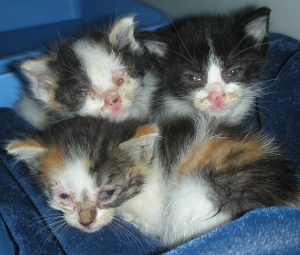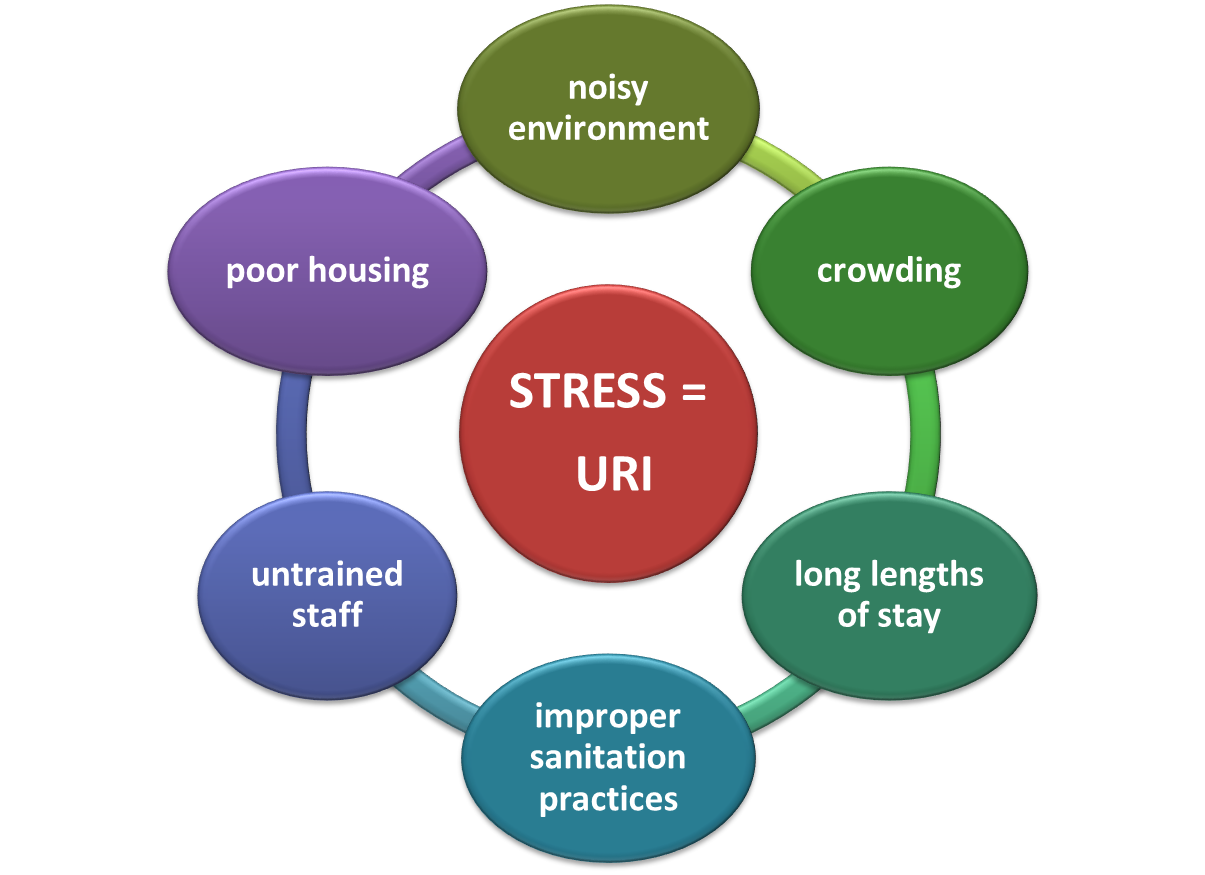Module 4: Healthcare practices for common contagious infectious diseases
Feline Infectious Respiratory Disease
Contagious respiratory infections are the most common cause of illness in cats in shelters and the most challenging to manage or prevent. These infections represent a significant and frequent drain on shelter resources, including treatment costs, staff time, and staff morale. Holding cats for treatment and recovery adds to the number of animal care days until adoption, which in turn impacts the housing capacity for the shelter and contributes to crowding and more disease spread.

Feline infectious respiratory disease (FIRD) or “Feline URI (upper respiratory infection)” is a clinical syndrome characterized by acute onset of sneezing, nasal and/or ocular discharge, oral and corneal ulcers, and sometimes pneumonia. Unlike dogs, coughing is not a typical clinical sign for cats. Feline URI is caused by a variety of viral and bacterial pathogens that infect the mucosal epithelium of the respiratory tract, damaging the tissues to cause the typical clinical signs.
Review the Feline Respiratory Infections in Shelters document to learn what pathogens cause Feline URI, their properties important to diagnosis and management, and the best tools for prevention. Knowledge of these common feline respiratory pathogens is fundamental to successful prevention and management of feline respiratory infections in shelters.
Key Takeaways for Feline Respiratory Infections in Shelters
- Feline URI is caused by several contagious respiratory viruses and bacteria.
- 80-90% of feline URI is caused by feline herpesvirus (FHV) and feline calicivirus (FCV).
- Both FHV and FCV cause sneezing, ocular and nasal discharge, and oral ulcers. FHV also causes corneal ulcers. The clinical disease can persist for 1 to 3 weeks.
- Bordetella causes sneezing and nasal discharge, but coughing is a unique indicator of Bordetella infection. Bordetella infection causes severe life-threatening pneumonia in kittens.
- Chlamydia felis causes ocular disease, including conjunctivitis, chemosis, and blepharospasm.
- Strep zoo is a common pathogen in cats housed in sanctuaries and large-scale hoarding conditions where respiratory disease is rampant. Strep zoo has been associated with severe life-threatening URI and pneumonia. Unlike Strep zoo infection of dogs, hemorrhage in the lungs is not a characteristic of the infection in cats.
- The antibiotics of choice for Bordetella, Chlamydia, and Strep zoo are doxycycline, minocycline, and Clavamox.
- The incubation period for all of the known feline bacterial and viral respiratory pathogens is ≤1 week. Preclinical shedding occurs during the incubation period and many cats may have subclinical infections.
- Most cats shed FHV and FCV in ocular, nasal, and oral secretions for ≤1 month. FCV can be shed for up to 3 months in some cats.
- FHV infection is life-long due to viral latency in the facial trigeminal ganglia (persistent infection). Stress reactivates virus replication and shedding in at least 50% of cats but not all cats recrudesce with clinical disease.
- Kittens are very susceptible to acquiring primary FHV infection from direct or indirect contact with infected adults that start shedding reactivated virus within 1 week of entering the shelter.
- FCV can establish a persistent or chronic infection with intermittent shedding in some cats.
- Bordetella, Chlamydia, Mycoplasma felis, and Strep zoo may be shed for weeks if infected cats are not treated with appropriate antibiotics.
- Feline respiratory pathogens are spread by direct contact with sick cats, environmental and staff contamination (fomites), and contact with persistently infected asymptomatic cats that are shedding FHV or FCV. Feline pathogens are not transmitted by aerosols.
- Shelters should invest in diagnostic testing when cats have severe clinical disease, including pneumonia, severe ocular signs, severe oral ulcers, or coughing.
- PCR testing of pharyngeal swabs is the best diagnostic test.
- Isolation of sick cats is required for control of disease spread. In-cage isolation in a general housing ward is acceptable if the cat can be cared for without contamination of other cats.
Feline URI Risk Factors
Feline URI is strongly associated with poor housing conditions and poor population management practices that lead to long lengths of stay and crowding. The outcome of poor housing and population management is STRESS. Feline URI is directly linked to stress. Inappropriately-sized cages that don’t allow for natural behaviors, high stocking densities in rooms, noisy environments, improper sanitation practices, and long lengths of stay are the greatest causes of stress. The risk for Feline URI increases with every day of residence in the shelter, reaching 80% by the end of the first week. The cornerstone for preventing or minimizing Feline URI in shelters is reduction of stress through proper housing and short lengths of stay.


